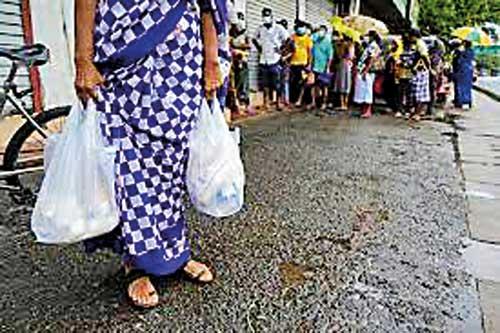21 Jun 2022 - {{hitsCtrl.values.hits}}
Sri Lankans are entrapped in a massive-scale livability crisis, as their incomes do not keep pace with the prices, after the authorities plunged the country into an unprecedented economic crisis characterised by hyperinflation.
According to the latest data, the wages of the Sri Lankans are lagging far behind the rise in the prices of what they buy daily for their sustenance, reflecting they are becoming financially worse off much faster than their earlier generations.
 For instance, according to the Wage Rate Index, for the informal private sector employees, their earnings have increased by 25.8 percent in April from a year ago but the prices rose by just shy of 30 percent in the Colombo district and by 33.8 percent nationally in April over the same period last year.
For instance, according to the Wage Rate Index, for the informal private sector employees, their earnings have increased by 25.8 percent in April from a year ago but the prices rose by just shy of 30 percent in the Colombo district and by 33.8 percent nationally in April over the same period last year.
In May, the Colombo district prices rose by just shy of 40 percent while the food prices rose by 57 percent, reflecting that their wages are not even remotely close to enable them to maintain their lifestyles, meeting their basic needs. Unlike in the developed markets, over 60 percent of the incomes of a Sri Lankan is spent on food and when the food prices rise more than twice the rate of their wage growth, that reflects a family may be either forgoing a meal or is forced to significantly reduce the daily calorie intake required by a person.
One in every 20 children are found to be facing malnutrition, thanks to President Gotabaya Rajapaksa’s organic fertiliser lunacy.
Making matters worse, Sri Lanka is now facing a food crisis, where a large majority of the people are losing access to basic food items.
The situation becomes far worse in the case of a state sector employee, whose wages have risen by only 16.1 percent in the 12 months to April 2022, while the prices were rising twice or thrice the rate.
The Wage Rate Index is a proxy for how fast the wages in the state sector and informal private sector increase in a given period. A meaningful comparison could be made when the increase in the index is read with the rate of inflation in an economy. Given the runaway prices in the Sri Lankan economy since December last year, Sri Lankans are losing their real incomes at a much faster rate.
However, the higher wages could worsen the problem, as it could trigger wage spiral inflation at a time when the prices are pressured by significant supply shortages.
Hence, the authorities took a slew of measures in the last few months to destroy demand.
While inflation is a global problem after repeated self-inflicted policy blunders by the world’s central banks and governments, the latest of which was the slapping of sanctions on fuel and other commodities imports by Russia, the impacts of which are felt more acutely by the developing countries such as Sri Lanka, given its shallow domestic manufacturing base and over-reliance on imports.
Sri Lankans for decades chose to trade and consume imported goods, which required no skills, instead of a much more difficult yet resilient manufacturing economy, which requires skills. When the imports stopped, the trading economy came to a halt, consumption became threatened and the unskilled workforce became unemployed overnight, as one group waits in queues with their three-wheelers while another group, who did nothing in government offices, could easily be made redundant when they are not required in offices.
08 Nov 2024 13 minute ago
08 Nov 2024 2 hours ago
08 Nov 2024 4 hours ago
08 Nov 2024 5 hours ago
08 Nov 2024 5 hours ago